Unable to tell a potjie from a bobotie, my wife and I arrived in Cape Town ready to eat. Armed with a list of must-try local specialties, we set out to explore the city in our favorite method: with our taste buds leading the way. As we sauntered down Cape Town’s hopping Bree Street in search of authentic South African food, we began to wonder, what makes food authentic anyway? If tourists frequent a certain locale, does that make the food any less authentic? If a restaurant is listed in a guidebook, does it somehow lose its authenticity? We suddenly weren’t sure which nearby eatery would be worth one of our precious few nights in the Mother City.
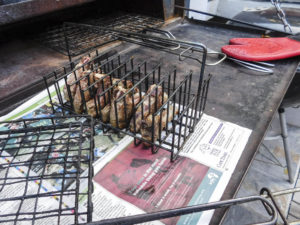
Locally-sourced lamb chops fresh off the braai- one of South Africa’s most treasured culinary traditions.
We slipped inside a nearby pub to ponder the decision before us and to do some additional research. Surely a local brew would provide us with a moment of clarity. After a quick internet search, we came across the company Traveling Spoon which organizes in-home dining experiences with local residents in cities around the world. Sharing a meal prepared by Cape Town residents in their own home sounded about as authentic as we could get. We excitedly booked our experience for later in the week.
Prior to the night of our dinner, our hosts Richard and Gillian reached out to us to ask what we would like to eat. We gave them free reign over the menu and said we would love to try whatever they thought would provide us with a true South African dining experience. We knew nothing about our hosts, as if we were going on a blind date. But a shared love of good food and wine does have a certain knack for breaking down any barriers.
A day later we arrived at Richard and Gillian’s cheerful residence in the suburbs of Cape Town and were greeted as if we were long-lost friends. We walked into a small, brightly lit home with volumes of books and Gillian’s own whimsical artwork lining the walls. The table was already set next to an inviting kitchen and a sliding glass door that led to a small garden and outdoor cooking area. We learned that Richard and Gillian have been restaurateurs for over 30 years and have been hosting guests in their home for about 12 months.
“I learned to cook by loving food,” Richard said. “My passion has always been cooking; it’s in my DNA.” Eager to learn what was in store for us, we inquired about the night’s menu. “There’s no such thing as South African cuisine,” explained Richard, “because there are so many outside influences.” Indeed, South African specialties include the aforementioned Dutch potjie (a meat and vegetable combination slow-cooked in a cast iron pot with a slew of Malay spices), and the bobotie (a curried meat and rice dish with an egg topping) which is thought to come from Indonesia. Perhaps our request of something South African had been a little vague.
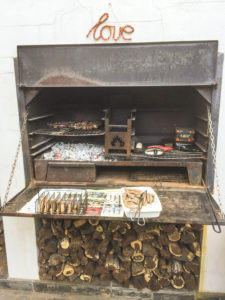
Richard and Gillian’s built-in braai outside of their Cape Town home.
Though defining South African cuisine may be a futile exercise, there does seem to be one unifying factor. “Braai is endemic of all of us,” Richard said of the term used to describe South African barbecue. “White, black, brown, yellow, green, we all cook over an open fire,” he said. Case in point: South Africa has 11 official languages and braai (rhymes with “cry”) is recognized in all of them. A descendant of the Dutch word braden meaning “to roast,” the word braai can be used as a noun to describe the actual cooking apparatus (“fire up the braai”) or the event as a whole (“we’re going to a braai”). It also works as a verb (“we’re going to braai some lamb chops”). Braaiing even has its own national day on September 24 which coincides with the Heritage Day holiday.
Since braai would be a natural fit anywhere in South Africa, that was Richard and Gillian’s choice for the evening. Unsure of the difference between a South African braai and the barbecue or cookout I was used to back home in Chicago, I asked Richard for a clarification. “The words braai and barbecue are interchangeable,” he said, though I suspected it wasn’t so simple given that braaiing is a South African national pastime.
For starters, there’s the fire. “Gas just isn’t the same,” Richard said. “I use Namibian hardwood because it makes good coals. ”A braai fire must begin with wood or coals, and the heat is key. As Richard’s Namibian hardwood burned, the heat was so intense that we could feel it radiating as we stood at the back door of the house at least 10 feet away from the fire.
The heat is also critical because of the lengthy time it takes for the flame to reach the desired temperature. Firing up a tank of propane and minutes later tossing on a burger or hot dog (neither of which you’ll ever see at a braai) would defeat the social purpose of braaiing. The slow rise in heat of a traditional wood-burning braai allows ample opportunity for conversation while the beer and wine flow.
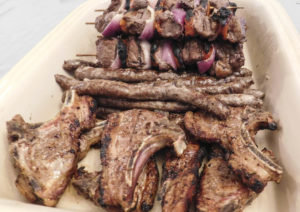
A proper braai will have several different cuts of meat.
A braai is liable to break out anywhere in South Africa, whether you’re in a suburban Cape Town house, a township on the outskirts of the city or the middle of the wilderness. It also can happen at any time, whether it’s a holiday celebration or because the sun happened to rise in the east that morning. “I usually braai three or four times a week,” Richard said as I watched him tend to his backyard built-in braai with the word “love” appropriately strung overhead.
“My dad would braai anything,” Richard said. “He’d braai in anything, rain or snow. For him, it was about being outside.” As Richard explained when we first arrived, the tradition of cooking outside is ingrained in South African culture. But that’s not to say the technique of braaiing hasn’t evolved over the years. “People used to use newspaper,” Richard said. “You’d cook on an inky, oily flame and that’s what they thought was braai in those days. My dad thought he was a good braaier. He was a terrible braaier.”
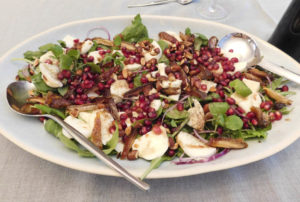
A side salad of watercress, pomegranate and mozzarella.
As Richard tended to the fire (a braai has a designated braaier), Gillian continued prep work inside where she was threading skewers with beef, red onion and unexpected slices of dried apricot. “The dried apricots are a South African touch,” she said. “They add piquancy to the kabobs.”
Gillian uncorked a bottle of Pinotage, South Africa’s signature red wine, and enlisted my wife’s help in mixing up a baked sponge dessert of malva pudding. “You’ll only find malva pudding in South Africa,” Gillian said. “The secret ingredient is apricot jam. It’s absolutely delicious.” After the pudding baked, Gillian poured a cream sauce on top to soak in.
As the fire reached its desired temperature, Richard began to put the meat on the braai. Whereas an American barbecue is likely to contain one cut of meat, a South African braai must have several. In addition to the beef kabobs, Richard tossed on some locally-sourced lamb chops seasoned with his own braai spice rub, venison sausages and mushrooms lathered in pesto. We all sat down together to an appetizer of chicken liver pate served on a homemade whole wheat and raisin bread.
As we ate, Richard fulfilled his duties as the braaier, bringing each cut of meat to the table when it was ready and ensuring that our wine glasses were never empty. Once we had exhausted the meat, Gillian proudly presented her malva pudding topped with cream for dessert. Meanwhile, Richard and Gillian’s teenage daughter Georgia eagerly aided us in planning activities for our last day in Cape Town.
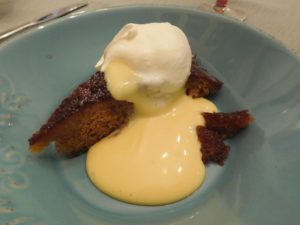
Malva pudding, South Africa’s signature dessert.
Around the evening’s second (or was it the third?) bottle of Pinotage, I began to think about what led us to Richard and Gillian’s house to begin with. It wasn’t just authentic food we were after, but rather a connection and sense of place that only a destination’s people can give you. We could have found braaied meat at any number of restaurants, but it never could have compared to dinner at Richard and Gillian’s. Standing at the fire with Richard, talking with Gillian about her art and planning the rest of our stay with Georgia was about more than just lamb chops. It was about the cultural exchange and sharing of customs between people from opposite ends of the earth who had been total strangers mere hours beforehand. That’s what makes conversation essential to a braai and why sharing food is so powerful. After all, the essence of Braai Day is to encourage all South Africans to come together regardless of their heritage.
We left Richard and Gillian’s with an open invitation to return and we extended them the same offer should they ever find themselves in Chicago. And there was one final benefit of our evening of authentic dining.
“Do you want to take a piece of malva pudding with you so you can have it for breakfast tomorrow?” asked Gillian. Of course I did.

another very interesting and well written article about your travels. I really enjoyed it!!!!